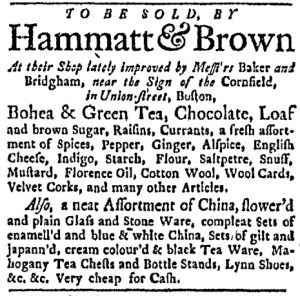In the twenty-first century, many people, including myself, skim over advertisements that appear in newspapers or magazines and oftentimes find them annoying. Before partaking in this project, I had little experience with interpreting advertisements nor had I given much thought to advertisements in the eighteenth century. However, as I dove into this project, I quickly began to recognize the importance of these advertisements as manifestations of culture in the eighteenth century.
In that period, print culture was an important aspect of society that I was able to see firsthand in the Adverts 250 Project. Newspapers were one of the colonists’ primary basis for communication with each other. In looking at them in the twenty-first century, they serve as a methodology in learning about everyday life in the American colonies in 1769 and the era of the American Revolution more generally. Analyzing advertisements from the newspapers printed in the colonies in 1769 improved my interpretation skills but also gave me a primary source glimpse into colonial life.
The Adverts 250 Project allowed me to “do” history. I had to not only read and understand the variety of advertisements that were printed, but I also had to do background research from credible sources to be able to get an inside look at the significance of the advertisements at this time. I took data from digital databases, primary sources, and secondary sources to be able to research and analyze each advertisement and then make it available to a variety of public audiences. Research to gain a full understanding of the topic was crucial, but I also had to keep in mind that this is a public history project. Picking advertisements that would be interesting to the general public was important. Because many others view this project daily, correct information and insightful analysis was crucial. An example of how this project allowed me to do history was the advertisement for a paint store I analyzed on March 4. In today’s society, anyone can buy a $30 can of paint and color their house white, red, blue, or tan without much thought. However, back in the eighteenth century, paint was expensive and certain colors were only available to the wealthy. It is important to look at these advertisements with an eye focused on the culture of the eighteenth century and how it differs from the twenty-first century and be able to relay that to the public.

I was able to go to the American Antiquarian Society to access their databases and see original editions of some of these newspapers with my own eyes. Students at Assumption College are blessed to be so close to the Antiquarian Society, where I was able to access the largest collection of early American newspapers in the world. Thanks to this research library, I was able to contribute to the Adverts 250 Project by using their collections to get a more complete view of American culture in the eighteenth century.
One of my favorite parts about this project was really digging deep into certain subjects. I used outside sources to be able to fully analyze and understand the cultural importance that a short advertisement can provide. For example, the advertisement I analyzed on March 7 was about flour of mustard. An archeological study of mustard bottles found at a Loyalist homestead in Canada showed the shift from imported British goods to goods grown and sold in the colonies and, eventually, the new nation. The advertisement proudly states “The best New-England Flour of Mustard.” Through this advertisement, we see the important shift from reliance of British goods to the colonies attempting to become more self-sustaining. However, this was also one of the most difficult aspects of the project. There are so many avenues that I could research in each ad that sometimes it was difficult to choose what part I wanted to analyze.
This brings us to another important aspect of the Adverts 250 Project that I loved. Advertisements were a window into an emerging pride and nationalism in colonial America. As the colonists become more connected with each other through print culture, including newspaper advertisements, thoughts about revolution began to swirl. As I mentioned earlier with the mustard advertisement, colonists were trying to become self-sufficient and did not want to rely on Britain for everything. This is exhibited in advertisements in the eighteenth century newspapers that I was able to explore in the Adverts 250 Project.
The Adverts 250 Project got me thinking: in 250 years will historians look back to our society now and analyze the advertisements in our newspapers and other media? What will they tell future researchers about the early twenty-first century? Overall, this project enriched my understanding of the products and services that people in the colonial and Revolutionary periods relied upon. We can see their needs on a day-to-day basis. I was able to participate in writing history by asking the question: “why does this matter?” With each advertisement I interpreted, I was able to go deeper and discover different aspects of colonial society. I am fortunate to be able to participate in the Adverts 250 Project this semester and I hope to be able to work with Professor Keyes again in the future.







